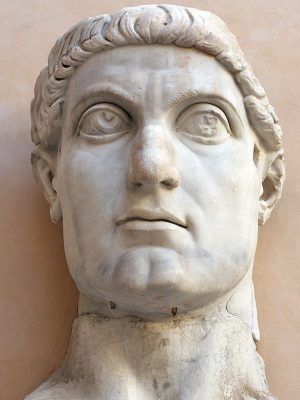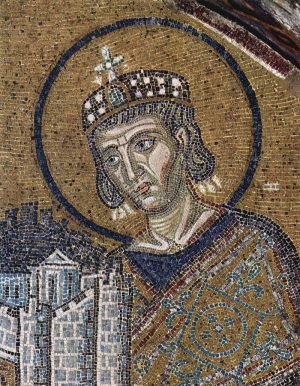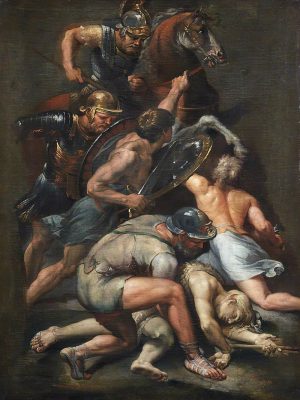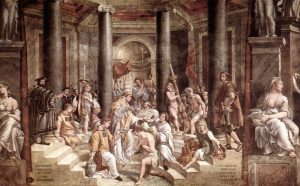Flavius Valerius Constantius, popularly known as Constantine the Great or Constantine I, was born around 272 in Moesia, modern-day Serbia. His father was Constantius Chlorus, a general who would become emperor, and his mother was Helena, a woman born into a family with low status.
Early Life
In 293, Diocletian introduced the Tetrarchy system where the western and eastern portions of the empire were ruled by their own emperors. Each emperor had his own Caesar, or junior emperor, who would later replace the emperor and would himself appoint his own Caesar. Diocletian took the eastern part of the empire and assigned his general, Maximian, to take charge of the west. Constantine’s father, Constantius Chlorus, was designated as Maximian’s Caesar, while Diocletian chose Galerius as his.
Constantius Chlorus knew he would eventually be emperor, so he primed his son, Constantine, to be his Caesar. Chlorus sent him to Diocletian’s court in the east for him to acquire the ways of an emperor and to learn literature and philosophy. After fulfilling his studies, Constantine served as a commander under Galerius when they fought the Persians in 298-299.
In 305, Diocletian and Maximian retired from being emperors of the western and eastern halves of the empire, and Constantius Chlorus and Galerius succeeded them. Contrary to expectations, Constantine was not chosen as his father’s Caesar. Maximian’s son, Maxentius, who was expecting to be appointed as Caesar, was also ignored. Instead, the power-hungry Galerius appointed Severus and Maximinus Daia as Caesars, as both men were subservient to him.
Rise to Power
Even though his father was now emperor of the western half of the empire, Constantine was still on the premises of Galerius’ court. To avoid becoming a pawn in Galierius’ power schemings, Constantine was called by his father to join him in the west. Galerius allowed this at first but later changed his mind. He ordered his men to take back Constantine, but it was too late, as Constantine had met with his father in Eboracum.
Soon after, Constantine joined his father in a battle against the Picts, a northern tribespeople from Scotland. After this campaign, they returned to Eboracum in 306, where Constantius Chlorus started weakening from an illness. Before dying, Chlorus recommended his son to his legions. His legions, in turn, swore their loyalty to him and declared Constantine their new emperor. Not long after, Constantine had the backing of Britannia and Gaul. He then sent word to Galerius and asked to be formally recognized. Galerius seethed at this news, as the Tetrarchy had been violated. He realized with bitterness that a civil war was not worth it, and so he granted Constantine rulership, but only as a Caesar.
Reign
In the first months of his rule, Constantine strengthened the borders to keep the Picts away. A Germanic tribe called the Franks heard of the newly-installed Caesar, and they decided to test his mettle by invading Gaul. Constantine responded by heading to the harassed territory and crushing the invaders. He took captive the Frankish kings Ascaric and Merogais and their soldiers. As punishment, Constantine had them thrown into the Trier Amphitheater, where they were torn apart by wild beasts.
Constantine was now the object of envy of Maxentius, the son of the former emperor, Maximian. Maxentius eventually proclaimed himself emperor, sending Galerius into a rage. Galerius then ordered his Caesar, Severus, to crush Maxentius’s troops. However, Maxentius bribed Severus’ men, making Severus’ command weak, and he eventually surrendered to Maxentius. Galerius decided to confront Maxentius himself and moved with his troops towards Italy. Before he even arrived, however, he learned that Maxentius had joined forces with his father, Maximian, and now the two had a massive army. Galerius’ men started abandoning him, forcing him to fall back to his eastern headquarters.
Shortly after, Maximian and Maxentius approached Constantine with respect. They assured Constantine that all three of them could rule the west and not meddle with Galerius’ eastern empire. The father and son tandem then proposed to Constantine that he marry Maxentius’ sister, Fausta, to seal an alliance. Constantine ignored these suggestions and, instead, resumed his military operations against invaders on the Rhine.
A year later, Maximian attempted to seize power from Maxentius but eventually failed as Maxentius’ troops stood by their leader. Fearing for his life, Maximian sought safety in Constantine’s headquarters in Gaul. The news of political volatility reached Galerius in the east, and he called for a meeting to settle matters. It was proposed during the talks that Maximian should give up his ambitions to the throne and go back to retirement, and Constantine should be relegated to being Caesar. Maximian agreed to this proposal, but Constantine did not. Constantine had been emperor for three years now and felt he had enough power to hold his own. Galerius sensed this and eventually acknowledged Constantine as emperor.
Maximian attempted to seize power one last time in 310 by spreading word that Constantine was dead. After this, he announced himself emperor. The misinformation attempt failed as Constantine’s men learned that their leader was still alive. Maximian had to flee to Marseille for his safety. Upon hearing of the misinformation attempt by Maximian, Constantine abandoned his military operations and marched his troops to Marseille. Constantine ordered the rebel to commit suicide, which Maximian did by hanging himself.
In 311, Galerius died. This emboldened his junior emperor, Maximinus, to try to seize the throne. To achieve that, he first had to clash with Licinius, whom Galerius declared co-emperor in 308. Meanwhile, on the western stage of the empire, Constantine was preparing to battle against Maxentius, who was looking to avenge his father’s death.
In the middle of this political chaos, Constantine wisely joined forces with Licinius. He arranged for his ally and sister to marry, forming a political union. Confident of his military might, Constantine then marched his troops toward Rome to destroy Maxentius and his men. Maxentius soon learned that Constantine’s troops had swelled to 40,000 along the way. He prepared for a siege but eventually changed his mind and chose to meet Constantine’s troops head-on. He positioned his troops near the Milvian Bridge, near the Tiber River. He had already destroyed a portion of the bridge to stave off the enemy’s approach and built a wooden bridge alongside it for his troops’ use.
Meanwhile, as Constantine was leading his soldiers to the battlefield, he gazed at the setting sun. At that moment, he claimed he saw a cross of light where the sun was, and above it, the words, “In this sign, you shall conquer.” Constantine took this as a sign of divine assurance of his victory. Consequently, historians consider this incident as the moment when Constantine started to adopt the Christian faith.
The following day, the fighting began. Constantine made brilliant use of his cavalry, splitting the ranks of Maxentius’ cavalry. Constantine’s troops soon hurled a heavy attack on Maxentius’ troops, pushing them to drown in the river. The surviving soldiers scampered back using the wooden bridge, but the structure collapsed, and many more of Maxentuis’ men drowned. Maxentius himself drowned in the river, and his body was found the following day. His head was cut off and carried around in the streets.
After his victory in what came to be known as the Battle of Milvian Bridge, Constantine’s popularity grew. He met again with his ally, Licinius, and together, they issued the Edict of Milan in 313. This edict officially ordered the toleration of Christianity in the empire.
The good relations between Constantine and Licinius started to collapse in 318. When Constantine’s troops chased nomadic Iranian tribes into the Danube, Licinius warned that the area was his territory. Constantine trampled again into Licinius’ territory when he chased the Goths, and this time, a war broke out between the two of them. Constantine eventually defeated his enemy in their many confrontations, prompting Licinius to seek support from the Goths. He was, however, arrested in Thessalonica, in Greece, and was ordered hanged by Constantine.
Legacy
As the sole ruler of Rome, Constantine founded the city of Constantinople in Byzantium, in modern-day Turkey. Constantine ordered the destruction of statues and temples of Roman gods and built the Church of the Holy Apostles where the Temple of Aphrodite formerly stood. He fostered the Edict of Milan by heaping money on Christian causes and appointing Christians to government posts.
The latter part of Constantine’s reign was stained by the mysterious deaths of his wife, Fausta, and his son, Crispus. Some historians believe Constantine had them executed because Crispus was having a sexual affair with his stepmother, Fausta. Other historians believe Crispus impregnated Fausta and that Constantine exiled him to Pola, where he was later poisoned or committed suicide. Another theory about Fausta’s death states that she died during an attempted abortion, while still another holds that Constantine had her suffocated in a hot bath.
Death
In 337, while preparing for war against the Persians, Constantine fell ill. With his remaining strength, he traveled to his mother’s city of Helenopolis, and there, he prayed in a church. It soon became clear to him that the end was near, so he sent for a bishop to baptize him. After being baptized, he was moved to a town near Nicomedia, where he died on the 22nd of May, 337. His three sons by Fausta succeeded him: Constantine II, Constantius II, and Constans I.
Constantine the Great was laid to rest in the Churches of the Holy Apostles in the city of Constantinople. He was the first Roman emperor to have converted to Christianity, and his reign triggered Christianity’s rise as the world’s most dominant religion.



